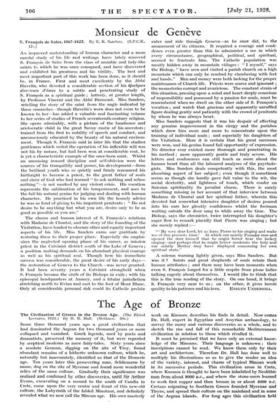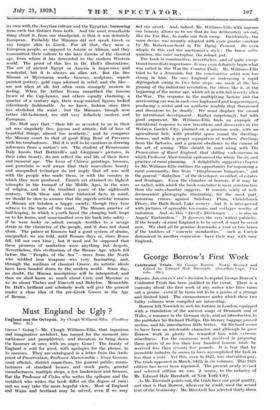The Age of Bronze SOME three thousand years ago a
great civilization that had dominated the Aegean for two thousand years or more collapsed and vanished. Greek legends, used by poets and dramatists, preserved the memory of it, but were regarded by sceptical moderns as mere fairy-tales: Sixty years since a resolute German, digging_ on the site of Croy, found abundant remains of a hitherto unknown culture, which he, naturally but inaccurately, identified as that of the Homeric age. Ten years later this persevering man, Schliemann by name, dug on the site of Mycenae and found more wonderful relics of the same culture. Gradually their significance was realized and confirmed by other discoveries, until Sir Arthur Evans, excavating on a mound to the south of Candia in Crete, came upon the very centre and fount of this new-old culture, the Labyrinth of the fabled Minotaur, and definitely revealed what we now call the Minoan age. His own masterly
work on Knossos describes his finds in detail. Now comes Dr. Hall, expert in Egyptian and Assyrian archaeology, to survey the many and various discoveries as a whole, and to sketch the rise and fall of this remarkable Mediterranean civilization in relation to those which rivalled it.
It must be premised that we have only an external know- ledge of the Minoans. Their language is unknown ; their inscriptions cannot be read. We know them only by their art and architecture. Therefore Dr. Hall has done well to multiply his illustrations so as to give the reader an idea of the variety, interest, and charm of typical Minoan work in its successive periods. This civilization arose in Crete, where Knossos is thought to have been inhabited by Neolithic man from about MO B.c., and where the stone-users learned to work first copper and then bronze in or about 4000 B.C. Cretans migrating to Southern Greece founded Mycenae and Tiryns, and spread their culture on the mainland and in some of the Aegean islands. For long ages this civilization held
its own with the Assyrian culture and the Egyptian, borrowing from each but distinct from both. And the most remarkable thing about it, from our standpoint, is that it was definitely European. Probably the Minoans did not speak Greek or any tongue akin to Greek. For all that, they were a European people, as opposed to Asiatic or African, and they transmitted their culture to the later Greeks of the classical age, from whom it has descended to the modern Western world. The proof of this lies in Dr. Hall's illustrations. The art of ancient Egypt or Assyria is impressive and wonderful, but it is always an alien art. But the fine Minoan or. Mycenaean works—frescoes, sculpture, superb painted pottery, gold cups adorned in relief, and the like— are not alien at all, but often seem strangely modern in feeling. When Sir Arthur Evans unearthed the famous
frescO of the - rtCuP-bearer, and others equally charming, a quarter of a century ago, their wasp-waisted figures looked ridiculously fashionable. As we know, fashion since then htti abolished the waist ; but the Minoans, though now rather old-fashioned, are still very definitely modern and European.
Dr. Hall says that " their life as revealed to us in their art was singularly free, joyous and artistic, full of love of beautiful things, almost too aesthetic," and he compares the Minoan court to that of good King Rene of Provence with his troubadours. But it is well to be cautious in drawing inferences from a nation's art. The student of Renaissance Italy knows that Botticelli's and Giorgione's pictures, in their calm beauty, do not reflect the real life of their fierce and immoral age. The lover of Chinese paintings, bronzes, and porcelain is well aware that their marvellous beauty and unequalled technique do not imply that all was well with the people who made them, or with the country in which they were produced. French art attained its highest triumphs in the turmoil of the Middle Ages, in the wars of religion, and in the troubled years of the eighteenth century. With these and other historical facts in mind, we should be slow to assume that the superb artistic remains of Minoan art betoken a happy society, though they bear witness to the taste of the court. The Minoan practice of bull-leaping, in which a youth faced the charging bull, leapt on to his horns, and somersaulted over his back into safety— if he were lucky or adroit enough—testifies to a savage strain in the character of the people, and it does not stand alone. The palace at Knossos had a good system of drains, unequalled, we are told, until Roman days or, since Rome fell, till our own time ; but it need not be supposed that these pioneers of sanitation were anything but despots. Nevertheless, this civilization of the Bronze Age, which fell before the " Peoples of the Sea "—races from the North who wielded iron weapons—was very fascinating, and, through the medium of classical Greece, its artistic ideals have been handed down to the modern world. Some day, no doubt, the Minoan inscriptions will be interpreted, and then we shall know as much about Crete and Mycenae as we do about Thebes and Nineveh and Babylon. Meanwhile Dr. Hall's brilliant and scholarly work will give the general reader a clear idea of the pre-Greek Greece in the Age of Bronze.





















































 Previous page
Previous page